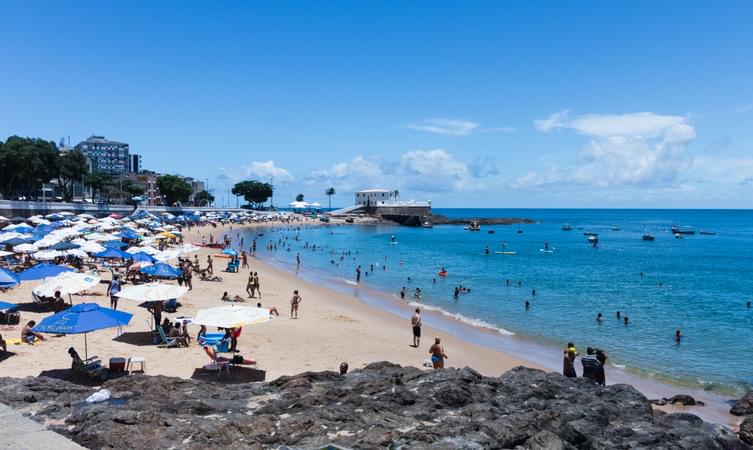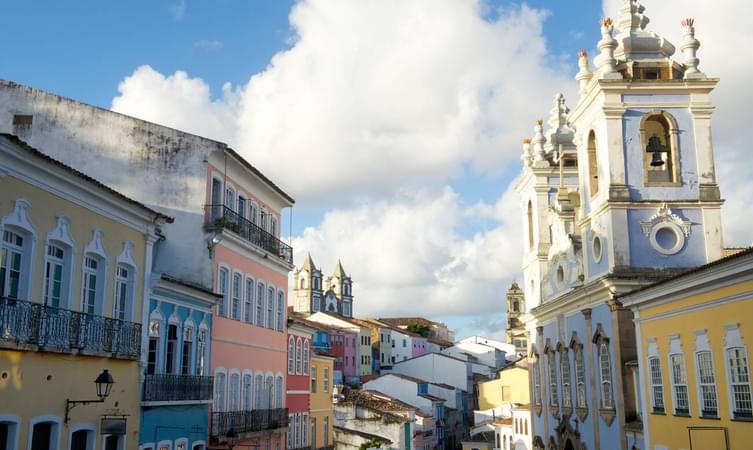.jpg?w=753&h=450&dpr)
Santo Antônio da Barra Fort, located in Salvador, Brazil, is a historic 16th-century fortress offering stunning ocean views. It houses the Nautic Museum of Bahia, showcasing maritime artifacts, ancient navigational instruments, and Brazil’s naval history, making it a must-visit cultural site.

Porto da Barra Beach, located in Salvador, Brazil, is one of the city’s most famous and picturesque beaches. Nestled in the historic Barra district, this small yet vibrant beach offers crystal-clear waters, golden sand, and a calm bay perfect for swimming and paddleboarding. As one of the few west-facing beaches in Brazil, it provides breathtaking sunset views, attracting both locals and tourists.
Rich in history, Porto da Barra was the landing site of the first European settlers in 1549. Today, it remains a lively spot with a mix of culture, music, and beachside vendors offering traditional Bahian snacks like acarajé. Its warm waters and relaxed atmosphere make it ideal for sunbathing and socializing. Whether you’re looking to enjoy the local culture, take a refreshing swim, or witness a spectacular sunset, Porto da Barra Beach is a must-visit destination in Salvador.
.JPG?w=753&h=450&dpr)
Mercado Modelo, located in Salvador, Bahia, Brazil, is a vibrant handicraft market housed in the historic former Customs House building. Inaugurated in 1912, it has become a major tourist attraction, offering a wide variety of Bahian crafts, souvenirs, and local products. The market features over 260 stores across two floors, showcasing items like traditional clothing, jewelry, wood carvings, and musical instruments.
Visitors can also enjoy local cuisine at restaurants like Maria de São Pedro and Camafeu de Oxóssi, which offer stunning views of the Bay of All Saints. The market's neoclassical architecture and rich history make it a must-visit destination. Its proximity to landmarks like the Lacerda Elevator and Pelourinho adds to its appeal, making it an integral part of Salvador's cultural and commercial landscape.

Pelourinho, the historic center of Salvador, Brazil, is a UNESCO World Heritage Site renowned for its vibrant colonial architecture and rich Afro-Brazilian heritage. The name "Pelourinho" originates from the Portuguese word for "pillory," a structure used for public punishment during the colonial era. This neighborhood was once the heart of Brazil's first capital and a major hub for the transatlantic slave trade, making it a poignant site for understanding the country's complex history.
.jpg?w=753&h=450&dpr)
Largo do Pelourinho is a historic square located in the heart of the Pelourinho neighborhood in Salvador, Brazil. Known for its vibrant colonial architecture and cultural significance, this charming square is a UNESCO World Heritage site. The name "Pelourinho" refers to the old pillory that once stood here, a symbol of Brazil’s colonial past.
Today, the square is a bustling hub for both locals and tourists, offering a unique glimpse into the city’s rich history and Afro-Brazilian culture. The area is filled with colorful buildings, cobblestone streets, and ornate churches, including the impressive Church of Bonfim. It is also home to museums, art galleries, and lively street performances, making it a central point for Salvador's music, dance, and traditional festivals, such as Carnival. Largo do Pelourinho embodies the spirit of Salvador, where the past and present intertwine to create an unforgettable cultural experience.
Praca da Se

Praça da Sé in Salvador, Brazil, is a historic square in the city’s Pelourinho district. It offers stunning views of the Bay of All Saints and features monuments, street performers, and cultural events. Once home to the city’s first cathedral, it remains a lively hub where history, art, and local life blend seamlessly.




